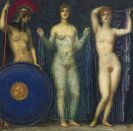
Fernand Khnopff
1858 Grembergen
1921 Brüssel
The Belgian painter, draughtsman, sculptor, etcher, lithographer and art writer Fernand Khnopff was born 12th September 1858 in Grembergen near Dendermonde. He grew up in Brügge and was completed his secondary education in Brussels, where he also attended university and began studying law.
When he was 20, Fernand Khnopff switched to art and became a student of Xavier Mellery (1845 – 1921), who taught him the fundamentals of painting. He then studied drawing for three years at the Brussels academy under the tutelage of James Ensor (1860 – 1949). Khnopff visited the World Exhibition in 1878 where the works of the Pre-Raphaelites and the Symbolist Gustav Moreau (1826 – 98) made a strong impression on him. He regarded Moreau as his main artistic influence. During the following year, he continued his studies for 6 months under Jules Joseph Lefèbvre (1836 – 1911). He then executed images of nature, focussing on very delicate light phenomena. He was an active member of a group of young Belgian artists that met as the "L’Essor", group, then as "Les XX" and finally as "Libre Esthétique" in 1894, in order to propagate and exhibit their work. Fernand Khnopff was by far the most important, surprising, and interesting presence within the group.
His early works include "En passant Boulevard du Régent" (1881), "Une crise" (1881) and "En écoutant de Schumann". In his painting "Sphinx" which was exhibited in the Paris World Exhibition alongside other works, Khnopff chose to pursue an idealistic-symbolic artistic direction in the manner of Edward Burne-Jones (1833 – 98) and Gustave Moreau. In his pastel work "Memories" (1889), the artist depicted his new English antique female type for the first time. This type would re-appear in many of his works. The work shows a group of seven tennis players. He completed a number of delicately characterised portraits of women and children, such as the image of Elisabeth von Österreich (1837 – 98) for Kaiser Franz I. (1830 – 1916) in 1900.
Fernand Khnopff was also a sculptor. Alongside an idealised, winged female mask, he made polychrome busts in marble or hard plaster. He also completed ten title pages in pastel and watercolour for French and Belgian poets and novelists. The artist exhibited at the World Exhibitions in Paris in 1899 and 1900. Khnopff also exhibited 21 pictures at the Wiener Secession in 1898. This led to his international breakthrough as an artist. In 2004, a retrospective exhibition of Khnopff’s work, containing approximately 265 of his works was held in Brussels at the Royal Museum.
Fernand Khnopff died on 12th November 1921 in Brussels.

Would you like to sell a work by Fernand Khnopff?
Infos for sellerART MARKET:

Urteil des Paris
Oil on panel, 1922
Estimated price 120.000
More offers >






